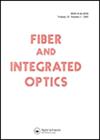绿色光网络的自适应节能方案:结合流量感知负载自适应路由和流量感知距离自适应路由
IF 2.2
4区 物理与天体物理
Q2 OPTICS
引用次数: 0
摘要
摘要当今,由于对能源危机和环境保护的关注,对先进技术解决方案的需求日益增加。特别是,随着近几十年来ICT设备的能源消耗迅速增加,人们越来越关注开发绿色信息和通信技术(ICT)解决方案。本文介绍了基于epso的流感知路由机制,该机制的目标是最小化排队延迟、功耗(能量耗散)和负载偏差。本研究采用两种流量感知机制,即流量感知负荷自适应方案(FA-LAR)和流量感知距离自适应方案(FA-DAR)。目标是通过选择流量最直接和最有效的路径来避免路线上的交通拥堵。这些路由路径使用基于mepso的FA-DAR路由算法进行优化,从而显着节省能源。广泛的数值模拟进行评估提出的算法使用指标,如吞吐量,路由效率,排队延迟,负载偏差,和能源效率。仿真结果表明,该方法在所有指标上都优于现有的基准方法。此外,它还保证了较低的功耗、排队延迟和负载偏差。与现有的基准方法相比,该方法的吞吐量提高了30%,能源效率提高了24%。关键词:流量感知距离自适应方案流量感知负载自适应方案路由流量需求链路利用率披露声明作者未报告潜在的利益冲突。人类和动物权利本文不包含任何作者对人类或动物受试者进行的任何研究。知情同意从研究中包括的所有个体参与者处获得知情同意。mathumohan Swamidoss在印度泰米尔纳德邦金奈的圣约瑟夫工程学院获得信息技术学士学位,在印度泰米尔纳德邦金奈的拉贾拉克什米工程学院获得软件工程硕士学位,并在印度泰米尔纳德邦蒂鲁内尔veli的Manonmaniam Sundaranar大学获得博士学位。目前,他在印度泰米尔纳德邦科维尔帕蒂的Unnamalai理工学院计算机科学与工程系工作。他在工程学院有超过11年的教学经验。主要研究方向为绿色光网络中基于能量的方案和图像处理。Duraimurugan Samiayya在印度泰米尔纳德邦Noorul Islam工程学院获得计算机科学与工程学士学位,在印度泰米尔纳德邦金奈安娜大学Guindy工程学院获得系统工程与运筹学硕士学位,并在印度泰米尔纳德邦金奈Sathyabama科学技术学院获得博士学位。目前,他在印度泰米尔纳德邦金奈圣约瑟夫工程学院信息技术系工作。他在工程学院有超过15年的教学经验。主要研究方向为多媒体流的拥塞控制和图像处理。Manikandan Gunasekar,他在印度泰米尔纳德邦圣约瑟夫工程学院获得计算机科学与工程学士学位。然后,他获得了印度泰米尔纳德邦圣约瑟夫工程学院计算机科学与工程硕士学位。他在印度金奈的Sathyabama科学技术学院获得博士学位,现就职于印度泰米尔纳德邦金奈的圣约瑟夫工程学院信息技术系。目前主要研究方向为无线传感器网络、移动网络。本文章由计算机程序翻译,如有差异,请以英文原文为准。
An Adaptive Energy-Saving Scheme for Green Optical Networking: Combining Flow-Aware Load Adaptive Routing and Flow-Aware Distance Adaptive Routing
ABSTRACTNowadays, there is an increasing need for advanced technological solutions due to concerns about the energy crisis and environmental protection. In particular, there has been a growing focus on developing green Information and Communication Technologies (ICT) solutions, as the energy consumption of ICT devices has been rapidly increasing in recent decades. This paper introduces EPSO-based flow-aware routing mechanisms that aim to minimize Queueing Delay, Power Consumption (Energy Dissipation), and Load Deviation. Two flow-aware mechanisms, namely, the Flow-aware load adaptive scheme (FA-LAR) and the flow-aware distance adaptive scheme (FA-DAR), are utilized in this study. The goal is to avoid traffic congestion across the routes by selecting the most direct and efficient paths for the flows. These routed paths are optimized using the MEPSO-based FA-DAR routing algorithm, resulting in significant energy savings. Extensive numerical simulations are conducted to evaluate the proposed algorithms using metrics such as throughput, routing efficiency, queuing delay, load deviation, and energy efficiency. The simulation results demonstrate that the proposed method outperforms existing benchmark methods in all metrics. Furthermore, it ensures lower power consumption, queuing delay, and load deviation. The method exhibits a 30% improvement in throughput and a 24% improvement in energy efficiency compared to existing benchmark methods.KEYWORDS: Flow-aware distance adaptive schemeFlow-aware load adaptive schemesroutingtraffic demandlink utilization Disclosure statementNo potential conflict of interest was reported by the author(s).Human and animal rightsThis article does not contain any studies with human or animal subjects performed by any of the authors.Informed consentInformed consent was obtained from all individual participants included in the study.Additional informationNotes on contributorsMathumohan SwamidossMathumohan Swamidoss obtained his Bachelor’s degree in Information Technology from St. Joseph’s College of Engineering, Chennai, Tamilnadu, India, and did his Master’s degree in Software Engineering from Rajalakshmi Engineering College, Chennai, Tamilnadu, India, and did his PhD Degree from Manonmaniam Sundaranar University, Tirunelveli, Tamilnadu, India. Currently, he is Working in the Department of Computer Science and Engineering at Unnamalai Institute of Technology, kovilpatti, Tamilnadu India. He has more than 11 years of teaching experience in Engineering College. His research interests include Energy-based Schemes in Green optical Networking and Image Processing.Duraimurugan SamiayyaDuraimurugan Samiayya obtained his Bachelor’s degree in Computer Science and Engineering from Noorul Islam College of Engineering, Tamilnadu, India, and did his Master’s degree in Systems Engineering and Operations Research from College of Engineering Guindy, Anna University, Chennai, Tamilnadu India-25 and did his PhD Degree from Sathyabama Institute of science and technology, Chennai, Tamilnadu, India-119. Currently, he is working in the Department of Information Technology at St. Joseph’s College of Engineering, Chennai, Tamilnadu India-119. He has more than 15 years of teaching experience in Engineering College. His research interests include Congestion control in Multimedia Streaming and Image Processing.Manikandan GunasekarManikandan Gunasekar obtained his Bachelor’s degree in Computer Science and Engineering from St. Joseph’s College of Engineering, Tamilnadu, India. Then, he obtained his Master’s degree in Computer Science and Engineering from St. Joseph’s College of Engineering, Tamilnadu, India. He received his PhD degree from Sathyabama Institute of Science and Technology, Chennai, India, and he is working at the Department of Information Technology, St. Joseph’s College of Engineering, Chennai, Tamil Nadu, India. His current research interests are Wireless Sensor Networks, Mobile Networks.
求助全文
通过发布文献求助,成功后即可免费获取论文全文。
去求助
来源期刊
CiteScore
3.40
自引率
0.00%
发文量
4
审稿时长
>12 weeks
期刊介绍:
Fiber and Integrated Optics , now incorporating the International Journal of Optoelectronics, is an international bimonthly journal that disseminates significant developments and in-depth surveys in the fields of fiber and integrated optics. The journal is unique in bridging the major disciplines relevant to optical fibers and electro-optical devices. This results in a balanced presentation of basic research, systems applications, and economics. For more than a decade, Fiber and Integrated Optics has been a valuable forum for scientists, engineers, manufacturers, and the business community to exchange and discuss techno-economic advances in the field.

 求助内容:
求助内容: 应助结果提醒方式:
应助结果提醒方式:


